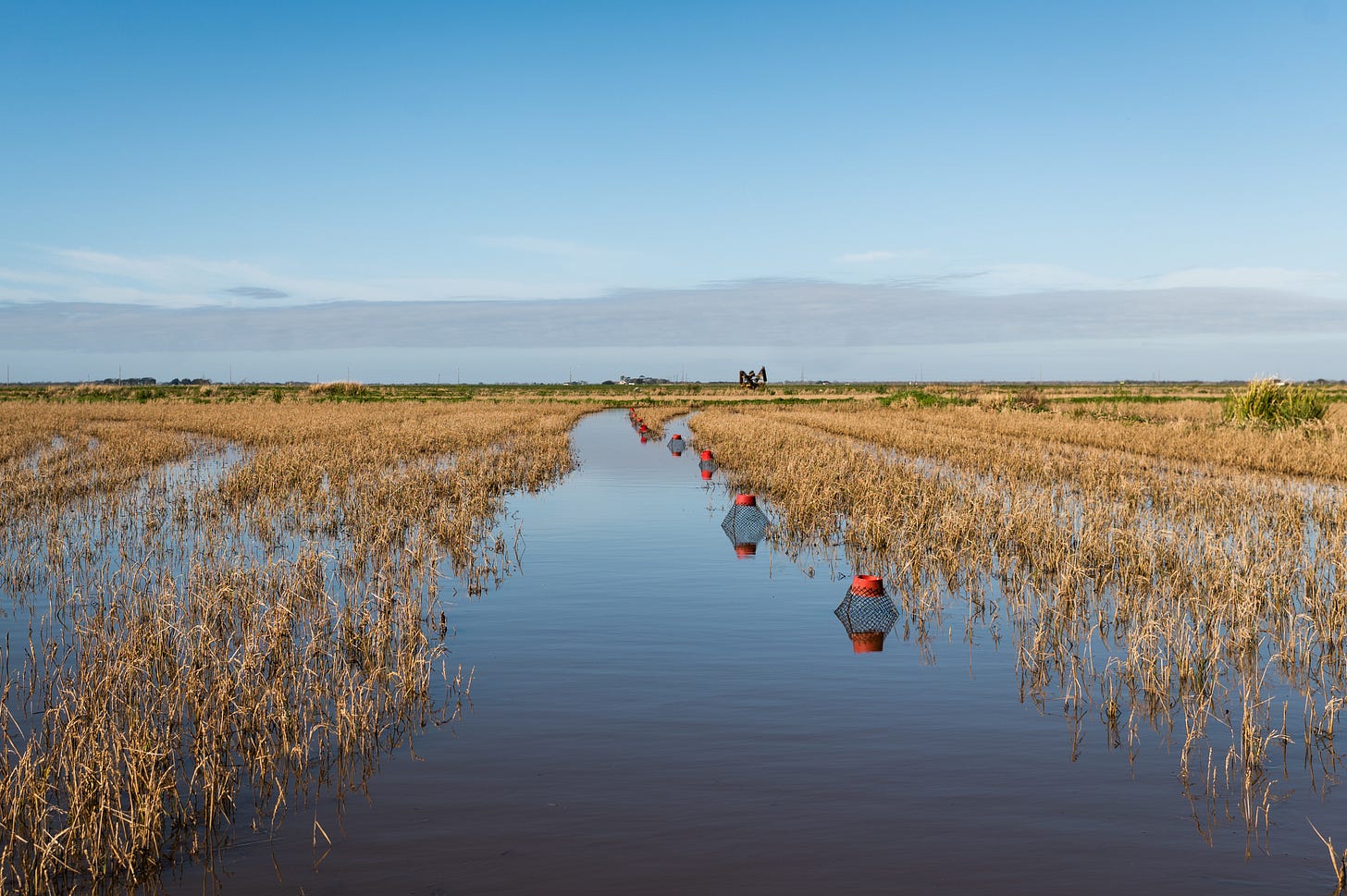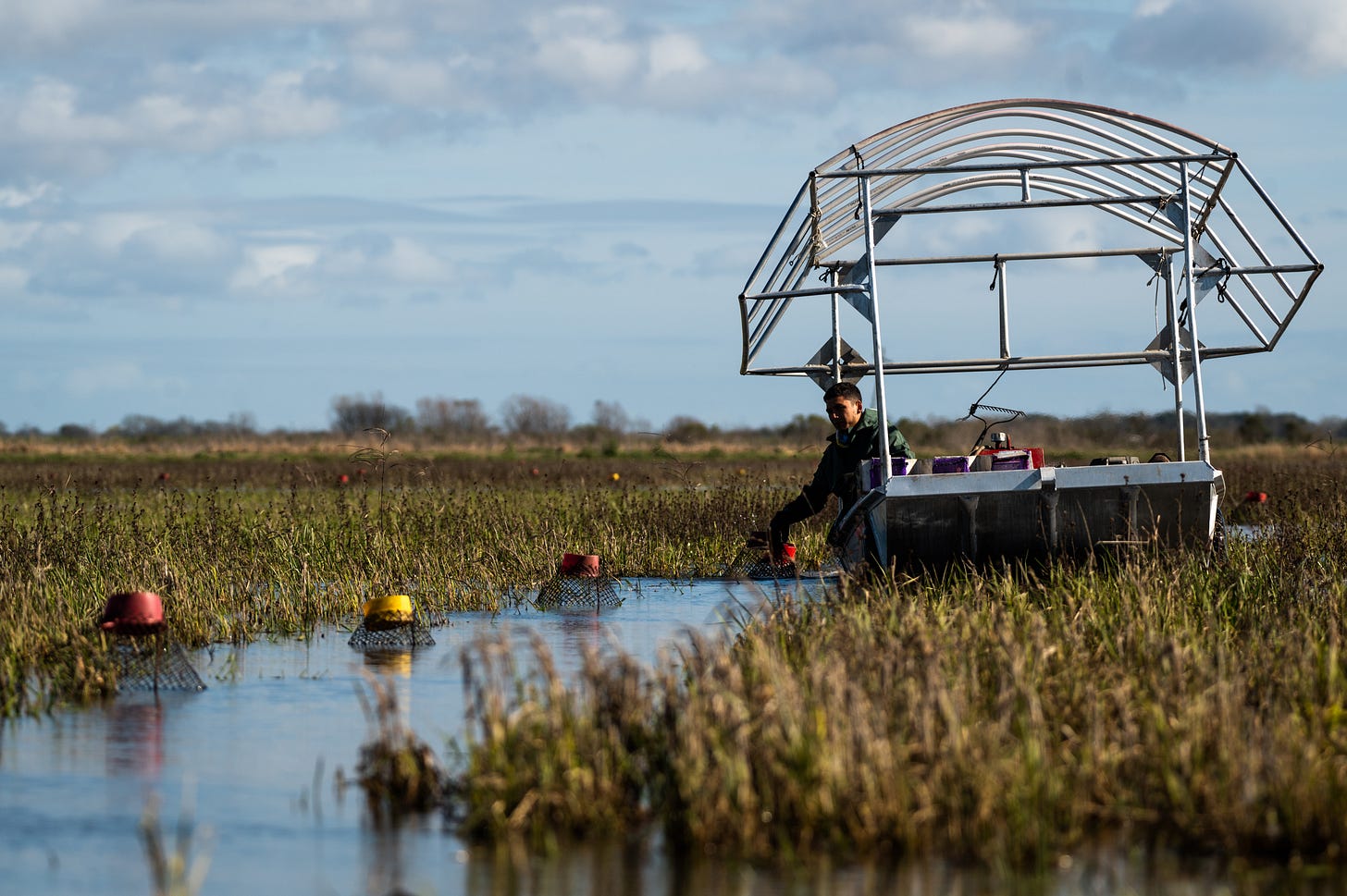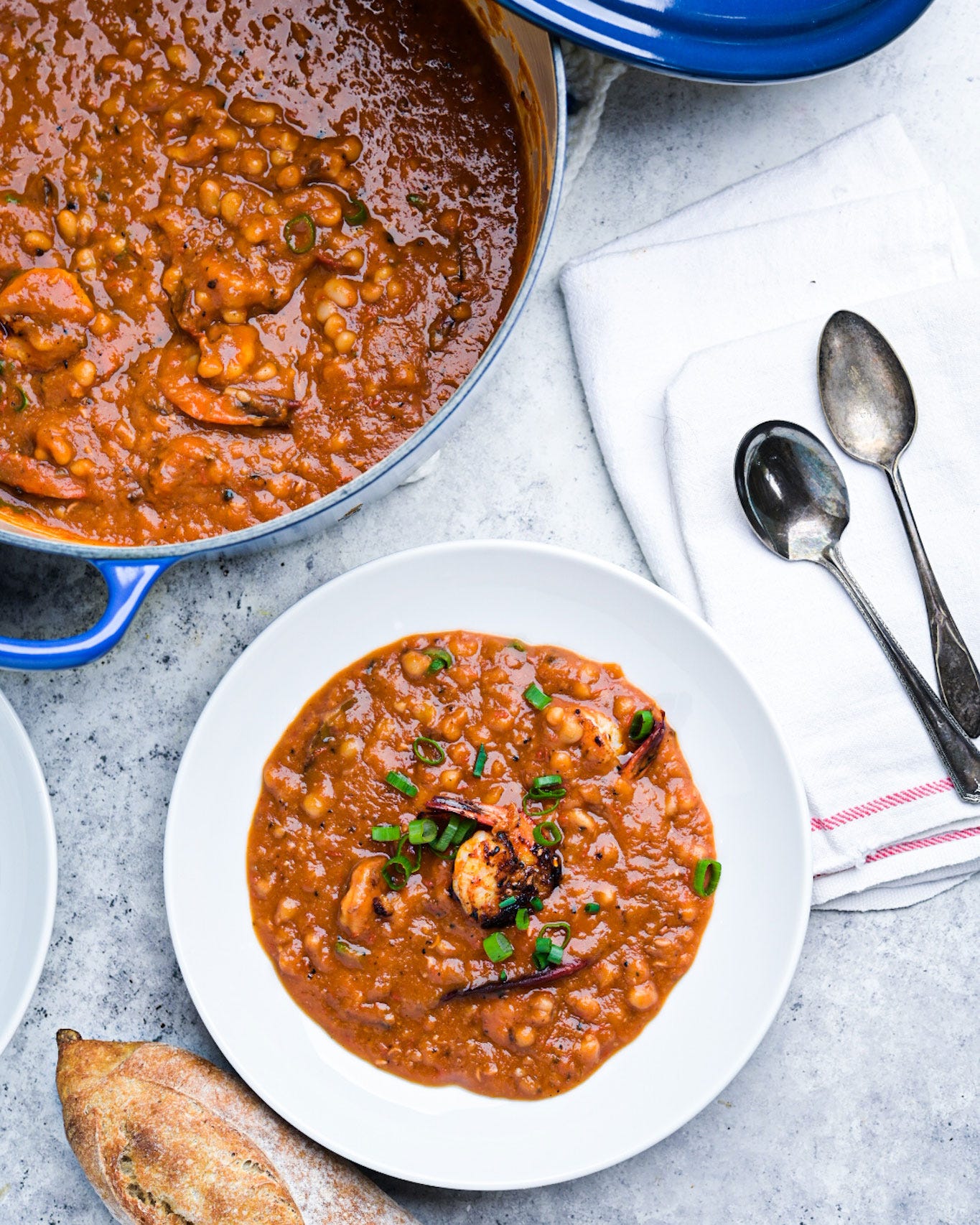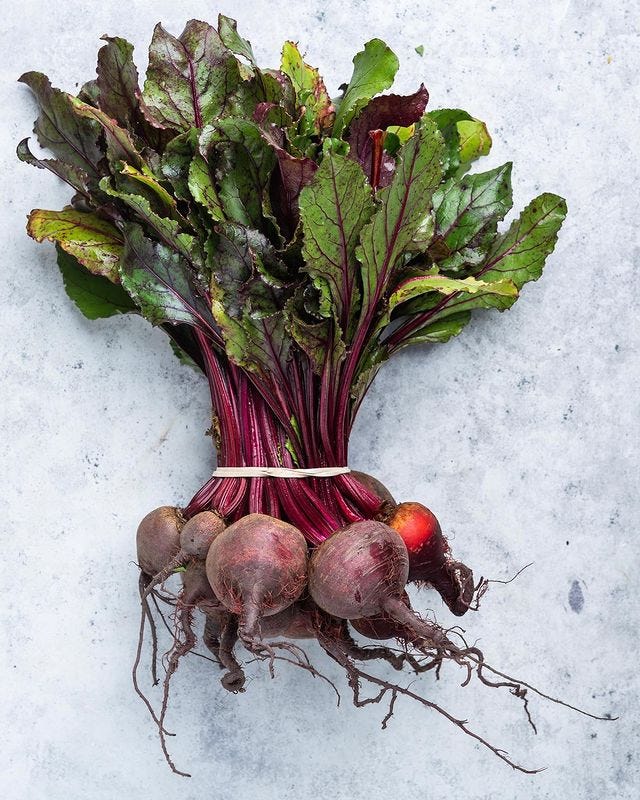Howdy folks,
It’s a big week over here: We’re celebrating Buddy Lee’s gotcha day, and (fingers crossed!) we’re finally getting some kitchen shelving. My dad helped me remove the upper cabinets when I first bought my house back in September, but I haven’t had enough confidence to replace them with open shelves on my own, so Rémy and I have been living with stacks of plates and spice jars and Dutch ovens spread across the countertop for months now. No one told me that “kitchen shelves” (or “learning how to stretch”) would factor into quality of life in my late 30s, but here we are—and we are very, very excited.
Today’s read is all about crawfish. Mudbugs. Crawdaddies. Cray…wait, nope, never mind. When I say I love crawfish, I need you to hear me: I LOVE crawfish. I ate some this morning, in fact—from the fridge—before I’d had a sip of coffee. Early season, late season, and everything in between, I want ‘em, I’ll eat whatever fixins they come with, and I don’t care about the price per pound.
In our last newsletter, I described the first boil of the season as a sort of intro to spring. Here, we’re going to look at crawfish as a center of community and learn a little about how they’re farmed from Madison McIntyre, one of three partners in Rayne & Welsh Wholesale, also known as The Crawfish Connection. I met Madison through Instagram early last year: I had reached out to several crawfish farms in hopes of documenting a harvest during the 2020 season (pre-COVID, that is), but hadn’t heard back from anyone, and then randomly, @the_crawfish_connection liked a photo of mine (#crawfish). I followed them, they followed me back, I slid into their DMs, and the following week I was on the farm. Classic story of boy-meets-farmer.
On the Farm with Madison McIntyre
Madison started The Crawfish Connection by leveraging relationships with farmers and boiling a few sacks a day, which he sold from a small lot on Oak Street in New Orleans. Born and raised in Rayne, Louisiana, he worked at a dock similar to the one he now manages as a young teenager and says he swore off coming back to the business. “From the age of 13,” he tells me, “I did exactly this, but for other people. We’d go do this after school, and then when we were done, we’d go to my dad’s friends’ restaurants and we’d start washing crawfish and boiling.” He says that at the time he hated the farming culture and wanted to get out—and did, for a while. But, he explains, “if you allow it, and you’re genuine, life will come back full circle.”
Madison started an executive transportation service in 2013, then sold that off when Uber announced they were expanding into Lafayette less than two years later. His family worked in oil and gas, but the oil field had just crashed, so that wasn’t an option. Then, a buddy asked if he wanted to boil crawfish in New Orleans. “I ran that little lot for $700 a month,” he recalls. “I’d bring like five to ten sacks there a day, and just have a little makeshift drive-through.” The owner of the lot told him about an upcoming po’ boy festival with thousands of attendees, so he rolled up early that Saturday with 45 sacks—about $3,000 worth of crawfish—only to learn that he’d been given the wrong date.
“We had no reefer trucks, just the pickup truck. We had no coolers—we had no infrastructure. We were just fly by night, small time. And so I just went and started knocking on doors. We went to Captain Sid’s and we went to Bevi and were like, ‘Y’all wanna buy some crawfish?’” Those cold calls led to sales, and a demand for more crawfish the next day. “That's how the wholesale business started—by accident.”
Today, Madison runs the dock, overseeing how many sacks the company is buying each day, the grade of the crawfish—select, field run, or peelers—and how those get distributed throughout their network of wholesalers. Casey Bergeron joined as a partner in 2018 and now runs the retail side of the business, along with managing catering and festivals. Charlie Johnson, a third-generation crawfish farmer, joined in 2019 and helps manage relationships in the fields. Though the Instagram account remains, the three partners formally dissolved The Crawfish Connection and formed Rayne & Welsh Wholesale, now one of the largest crawfish operations in the state.
In total, Rayne & Welsh owns about 1,500 acres, but they’re “committed” to another 4,500. Asked what exactly that entails, Madison explains that committed acres are another farmer’s land that they’ve agreed to buy from for the entire season. “You have a thousand acres, we’re buying a thousand acres of what you catch every day, no matter what.” Different properties start producing at different times of the year, but the whole operation is at the mercy of the crop. “We live by the crawfish.”
That’s the farming side of the business. In 2019, the team bought into Bayou Boil ‘n Geaux in Covington. Then in 2020, they bought a retail property in Welsh, which they opened just a few weeks ago as Parish Seafood Company. A fourth partner is now training at that location, and next year, he’ll open a wholesale/boil-and-go spot in Austin, Texas. “Then we’re going to take a break for a while,” Madison assures me, before laying out his vision for a small crawfish and steak restaurant in New Orleans. But the end goal, he explains, isn’t continued growth.
Unlike other seafood industries, crawfish are unregulated. To set prices, a group representing the state’s largest operations—the Big Five, Madison calls them—meets weekly to assess their inventory, and the price per pound goes up or down based on what’s in their coolers. “I don’t think I ever want to be that big,” Madison tells me. “It just seems like those guys have nothing but a headache. When they get stuck with crawfish, they get stuck with thousands of sacks, and that seems really, really stressful. And you let a lot of people down.”
That notion—of letting others down, and that there are small businesses depending on them—comes up several times in our conversation. “These people trust us with their whole entire crop. If we don’t get up everyday and do what we do, people literally can’t survive—from the farmers all the way to the seafood markets and the restaurants.” Of Rayne & Welsh’s 13 wholesale accounts, Madison says they’re the only supplier to at least nine.
When I first visited last February, Madison told me that he wouldn’t sell to a wholesaler until they had visited the farm and seen how they were doing things. A potential customer—a wholesaler out of Bogalusa—was visiting that same day, for the first time; we all gathered around a boil that evening, tasting the day’s catch. That wholesaler is now a regular customer, buying more than $200,000 worth of crawfish this season from Rayne & Welsh. (And funny enough, he was back on Monday when I rolled up for this interview, loading up a truck that was headed to North Carolina.)
Madison, Casey, and Charlie have extensive experience not just growing and selling crawfish, but also in cooking them, so I asked a few questions about their technique—of which, to be clear, I’m a big fan. The fixins are all cooked separately, and the crawfish are initially boiled in unseasoned water for just a couple of minutes, then transferred to ice chests, where they’re tossed in a mix of spices and lemon juice, then steamed for a few more minutes.
Among the advantages: A faster turnaround than the traditional soaking method, more intact fat at the base of the tail (because it’s not soaking in water during the cooldown), and consistent spice, whether they’re boiling 30 pounds or several thousand. I’ll repeat here how much I love crawfish—and however you’re cooking them, I’ll peel and eat with a smile on my face—but having tried these a few times now, this is definitely my preferred method.
Okay, so why don’t you season the boil?
There’s no food—a vegetable, steak, crawfish, fish—nothing that’s going to absorb seasoning over a certain temperature. It’s not absorbing any seasoning at all, it’s doing nothing but pulling out the moisture in that product. That’s why gumbos and gravies are so much better the next day.
How did y’all land on this method?
This guy I worked for, he actually pioneered it in 1996. His name’s Eric Thomas, and he started The Crawfish Hut, which is where I started working when I was like 11. Him and a few guys from that area, they kind of started that.
How do you know when crawfish are done boiling?
Whenever a pot is about to boil over, it’s gonna start to create this yellow foam on top of the water. That’s a key indicator that they’re ready to come out. Another key indicator a lot of people don’t know is that there’s going to be a white line where the head meets the tail. That’s going to pop out and become very visible. It don’t matter if you boiled it for a minute or six minutes: You see that white line, pull it.
If I’m throwing a boil, how many pounds per person should I plan for?
In-state, we say five pounds a person, but out of state, we quote three pounds per person.
How long will live crawfish keep once they’re harvested?
It all depends on what time of the year it is. Once you get to about the middle of April, they can easily live five to six days if you handle them right. This is from the wholesale side—once it gets to retail, it might only be two or three days.
What about purging, to clear out the digestive tract?
It’s a big myth. There’s two types of purging: There’s a salt purge—LSU has debunked it. It does nothing. A true purge is putting them in well water that has a lot of aeration, to starve them of food. And it’s 48 hours—anything less is not a true purge. Do I do it? No. I’m just gonna rinse and get the dirt off and grass out.
While you can’t buy directly from Rayne & Welsh, you can find their live crawfish at Captain Sid’s in Metairie. Or, buy them with fixins, boiled fresh at Bayou Boil ‘n Geaux in Covington and Parish Seafood Company in Welsh—both spots offer an easy drive-through!
Lagniappe
Looking to get your hands on some freshly boiled crawfish? There are too many spots to list, but you can download The Crawfish App, or check in with your favorite brewery—many have weekly partnerships with crawfish vendors. Speaking of beer: How about a crawfish pairing? Check out The Commissary’s Seafood Supper on April 23. Need something more festive? Nola Crawfish Fest is back this weekend at The Broadside. (Seriously though, if you walk a half mile in any direction right now, you should be able to find someone selling fresh bugs.)
Up next: a few videos about…you guessed it…crawfish. First, Claude Davis aka Dr. Boil offers some basic tips for boiling.
Next, Bayou Wild takes Miss Louisiana out to the crawfish ponds.
Over on Outside the Levees, Jared Serigne learns how to catch ‘em wild with swamp person Ronnie Adams.
And Wayne Haydin, Jr. narrates the missteps of a boil aired on Cooking Channel.
Lastly: Move over, Dan Pashman, we’ve already got the only pasta shape we’ll ever need:
What’s in the Pot?
You thought I was going to say crawfish, didn’t you? Nope, it’s beans. I’ve been cooking and shooting a lot of content for Blue Runner Foods lately while Rémy’s been testing recipes for an air fryer cookbook, so the fridge has been stocked with an interesting mix of leftovers. (If you have a favorite bean recipe, please send a link!)
Crawfish Boil Smashed Potatoes
A couple years back, crispy smashed potatoes were a thing for a hot minute. Around that time, on a random Monday night, I was gifted a to-go container filled with crawfish boil potatoes. I also had bacon grease on hand (you don’t?), so I used a heavy cast iron to gently smash those spuds till they were about half an inch thick, then I pan-fried them in the grease until crispy, flipping once to crisp up both sides before finishing with a sprinkle of flaky sea salt. The results shouldn’t be called a recipe, but they’re worth repeating:
Thanks for reading, and for supporting local food businesses. There’s a lot of new faces here—y’all reach out anytime with feedback, stories, or topics you’d love to see covered, or just to say hi!














